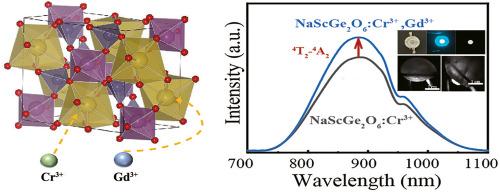The Gd3+ doping induced improvement of broadband NIR emission of NaScGe2O6:Cr3+ nanophosphors for contrast imaging lighting
IF 3.5
3区 化学
Q2 CHEMISTRY, INORGANIC & NUCLEAR
引用次数: 0
Abstract
Herein, nano-sized NaScGe2O6:Cr3+ phosphors (NSGO:Cr3+, 16–35 nm) were successfully synthesized via the sol-gel method. Cr3+ ions preferentially substitute for the Sc3+ sites by occupying octahedral sites with a weak crystal field strength (Dq/B = 2.00). A broadband emission was observed within the first Near-infrared biological transparency window (NIR-I), located at 893 nm, which can be assigned to 4T2→4A2 transition of Cr3+ in NSGO:Cr3+. The full width at half maximum of the emission peak is approximately 150 nm. When doping concentration of Cr3+ reached 0.003, its NIR emission intensity became the strongest. The corresponding Huang-Rhys factor (0.44) is less than 1, indicating relatively weak phonon-electron coupling. Subsequently, the luminescence intensity of NSGO:Cr3+ was increased ∼20 % via incorporating Gd3+ into NSGO:Cr3+(NSGO:Cr3+,Gd3+) phosphors. Their phonon energy decreased from 0.131 eV to 0.125 eV. Meanwhile, the thermal stability of the luminescence in NSGO:Cr3+,Gd3+ was enhanced, resulting in an increase in thermal activation energy from 0.255 eV to 0.275 eV. The emission intensity of NSGO:Cr3+,Gd3+ at 150 °C retained 26.3 % of that at 20 °C. By combining blue LED chip with NSGO:Cr3+,Gd3+ phosphors, a NIR-I phosphor conversion light-emitting diode (NIR-I pc-LED) was fabricated and utilized as a backlighting source for contrast imaging. Both NIR contrast imaging photos of plant and animal tissues were successfully acquired using a NIR camera and the NIR-I pc-LED.

Gd3+的掺杂提高了对比成像照明用NaScGe2O6:Cr3+纳米荧光粉的宽带近红外发射
本文采用溶胶-凝胶法制备了纳米尺度的NaScGe2O6:Cr3+荧光粉(NSGO:Cr3+, 16-35 nm)。Cr3+离子优先取代Sc3+位置,占据八面体位置,晶体场强较弱(Dq/B = 2.00)。在第一个近红外生物透明窗口(NIR-I)内观察到宽带发射,位于893 nm,可归因于NSGO:Cr3+中Cr3+的4T2→4A2跃迁。发射峰的半峰全宽约为150nm。当Cr3+掺杂浓度达到0.003时,其近红外发射强度最强。对应的Huang-Rhys因子(0.44)小于1,说明声子-电子耦合相对较弱。随后,通过将Gd3+掺入NSGO:Cr3+(NSGO:Cr3+,Gd3+)荧光粉中,NSGO:Cr3+的发光强度提高了约20%。它们的声子能量从0.131 eV下降到0.125 eV。同时,在NSGO:Cr3+,Gd3+中发光的热稳定性增强,热活化能从0.255 eV增加到0.275 eV。NSGO:Cr3+,Gd3+在150℃时的发射强度保持在20℃时的26.3%。将蓝色LED芯片与NSGO:Cr3+,Gd3+荧光粉相结合,制成NIR-I荧光粉转换发光二极管(NIR-I pc-LED),作为反差成像的背光光源。利用近红外相机和NIR- i pc-LED成功地获得了植物和动物组织的近红外对比成像照片。
本文章由计算机程序翻译,如有差异,请以英文原文为准。
求助全文
约1分钟内获得全文
求助全文
来源期刊

Journal of Solid State Chemistry
化学-无机化学与核化学
CiteScore
6.00
自引率
9.10%
发文量
848
审稿时长
25 days
期刊介绍:
Covering major developments in the field of solid state chemistry and related areas such as ceramics and amorphous materials, the Journal of Solid State Chemistry features studies of chemical, structural, thermodynamic, electronic, magnetic, and optical properties and processes in solids.
 求助内容:
求助内容: 应助结果提醒方式:
应助结果提醒方式:


